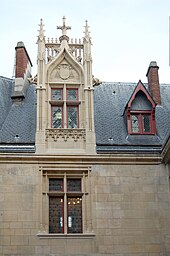Cross-frame window

The late Gothic cross Stock windows (also known as, cross window, or stone cross window hereinafter) has been known since the 14th century and replaced by apartment buildings formerly usual Romanesque or Gothic arch windows, since almost exclusively religious buildings were reserved. The two upper windows were usually a bit smaller than the lower ones and could be opened separately. The latter applies in a similar manner for a cross-floor window , which only a separating horizontal bolt (instead of the cross fighter has).
execution
The division of the rectangular window area into four individual windows is characteristic. The window crosses were originally made of stone ('stone cross window'); Only in the architecture of the Renaissance and the Baroque did the wooden cross-frame window develop (e.g. on the monastery castle of the Escorial and on other buildings in the Herrera style ). If the transverse timber is arranged in the middle, there are four individual windows of equal size; this division is called the 'central cross-frame window'. Later the windows were often six-part, with the two upper windows sometimes connected to one another and forming a kind of 'skylight'.
literature
- Meyer's Encyclopedic Lexicon . Bibliographisches Institut, Mannheim / Vienna / Zurich 1973, Volume 8, p. 638.